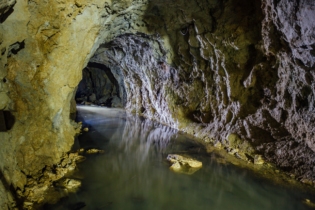The use of ultra filtration as the main treatment processes for the treatment of Cape brown water for potable use
By Herman Smit* and LizeMarie Tolken The need for two separate water treatment requirements at different locations in the holiday town of Pearly Beach in the Western Cape has been resolved with a single solution — use of ultrafiltration membrane technology. The ultrafiltration membrane system (which is manufactured locally) was specially constructed to provide for both the town’s current and anticipated future requirements as well as for the new development at the Caravan Park. The Overstrand Municipality had been faced with replacing its existing sand filters, pipework and valves at the Pearly Beach Reservoir, which was supplied with water from the local dam and supplemented on occasion by the smaller Bell’s dam. As this water was of very good quality, minimal treatment had been required. However, future supply from the springs provisioning the dams could not be relied upon and their location six kilometers east of the town was a further issue. Another problem was the high water losses resulting from backwashing the sand filters. Methods When it was decided to develop the Caravan Park the Services Agreement had stipulated that untreated water from a dam on the developer’s property be utilised. This water, however, although of good quality, was the typical brown colour of the area due to organic matter and therefore treatment was necessary. It was obviously logical to consider one water treatment work (WTW) with a larger capacity, which would be able not only to meet the summer water demand of both the town and the development — estimated at 1 440 kℓ/day — but also anticipated needs of an expected population increase of 5 000 people that would have a major impact on water resources. These future water requirements were assessed at 2 360 kℓ/day. A single treatment facility made sense from an operational, space and cost perspective. While it was possible to obtain the Class 1 water required for drinking water by either using conventional methods or membrane filtration the latter course was decided upon for a number of reasons. These included superior water quality, speed of installation, ease of operation, lessened environmental impact and provision for expansion. Ultrafiltration (UF) is able to remove colloidal solids and large molecular weight organics by implementing the processes of coagulation and flocculation before filtration. With UF only a pinpoint flock has to be formed thus saving in costs on dosing chemicals. UF is also less sensitive to pH changes in untreated water; such variations can have a negative impact on water quality. Significant too is that UF requires a smaller footprint and thus has less impact on the environment especially as chemical usage is minimised. Also important is that it is not labour intensive as it does not require highly skilled operation or full time supervision. Costs are not only saved in this area but also in the initial set-up and maintenance costs are either comparable or lower than more conventional WTW systems. Deciding to construct just a single WTW meant that the process was expedited, site assembly was fast and future upgrades accommodated due to the modular assembly capabilities. ResultsA study in association with the Cape Peninsula University of Technology to establish an optimum treatment procedure to produce constant, high quality drinking water for the community of Pearly Beach from a blend of white and coloured water supplied from two different water sources. Establishment of the optimal treatment procedure included the determination of the most effective coagulant and the optimum dosing level combined with the most effective blend of the two types of water.
Laboratory testing was done on different water blends dosed with different amounts of the different types of coagulants. The results were recorded in tables from which graphs were compiled and used in analyses. After analysis a preliminary treatment procedure was developed and commissioned on site. On-site testing was done to ensure that the blend, coagulant and coagulant dose commissioned were able to produce constant, high quality drinking water according to the standards set by SANS 241 for Class I drinking water. Further pH sensitivity testing was done to ensure that pH fluctuations in the two water sources would not affect the efficiency of the chosen coagulant. The main conclusion of the study was that a 60:40 blend of white and coloured water dosed with 1- 1.8 mg/ℓ ACH based coagulant and treated by ultrafiltration can produce constant, high quality drinking water. Conclusions The design for the treatment plant was based on the filtration study done regarding the coagulant effectiveness and the UF capabilities. The process stages are chemical injection on the feed line, a 150 micron strainer, Ultrafiltration, carbon filters as option and final Hypochlorite injection. Chemical injection is done on the feed line which feed into a buffer tank for the UF plant. This feed through a strainer that removes the coarse particles. The strainer is a protection precautionary measure for the UF membranes. From the UF plant the permeate flows into a filtrate tank. A waste sump is connected to the UF plant for backwash collection. The UF permeate can be diverted through carbon filters to remove the excess colour from the permeate, until the plant settings can be adjusted to accommodate the higher colour in the feed water. In line monitoring, before and after, the UF plant ensures the production of good quality drinking water. Should the plant operate outside specifications, it will automatically shut down. The dosage amounts can be varied by taking the measured parameters into account.
Siemens Memcor hollow fibre membranes were used as the UF membranes. The feed to the UF plant are variable and fully automated for variable feed water conditions. A flow control valve adjusts to the given conditions.
In line monitoring, before and after, the UF plant ensures the production of good quality drinking water. Should the plant operate outside specifications, it will automatically shut down. The dosage amounts can be varied by taking the measured parameters into account.
Siemens Memcor hollow fibre membranes were used as the UF membranes. The feed to the UF plant are variable and fully automated for variable feed water conditions. A flow control valve adjusts to the given conditions.







